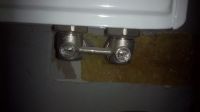Good morning,
I bought a house in which one of the radiators (powered from the bottom), as it turned out recently, is leaking at the upper valve. Hence my question: can I close the bottom screw connections (set the position to the horizontal lines) and unscrew the thermostat insert? Will my floor flood? I attach a photo of the insert and ask for help.
I attach a photo of the insert and ask for help.
best regards,
Christopher

I bought a house in which one of the radiators (powered from the bottom), as it turned out recently, is leaking at the upper valve. Hence my question: can I close the bottom screw connections (set the position to the horizontal lines) and unscrew the thermostat insert? Will my floor flood?
best regards,
Christopher




